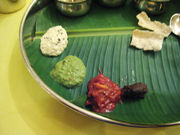Chutney
 |
|
| Origin | |
|---|---|
| Alternative name(s) | Chatni |
| Place of origin | India |
| Region or state | South Asia |
| Dish details | |
| Main ingredient(s) | salt, chillies, tamarind, coriander leaves, tomatoes |

Dakshin chutneys
|

Chutneys
|

Mango chutney
|

Simple tomato chutney
|

Eggplant and lemon chutneys from Goa
|

Traditional grinding stone used for making chutney in India
|
Chutney is a loan word incorporated into English from Hindi describing a pasty sauce in Indian cuisine.[1] It is derived from caṭnī (Tamil: சட்னி, Kannada: ಚಟ್ನಿ Hindi: चटनी, Urdu: چٹنی,Malayalam: ചമ്മന്തി) a term for a class of spicy preparations used as an accompaniment for a main dish. Chutneys usually contain an idiosyncratic but complementary spice and vegetable mix.
Chutneys usually are wet, having a coarse to fine texture. The Anglo-Indian loan word refers to fresh and pickled preparations indiscriminately, with preserves often sweetened. At least several Northern Indian languages use the word for fresh preparations only. A different word achār (Hindi: अचार) applies to preserves that often contain oil but are rarely sweet. Vinegar or citrus juice may be added as preservatives, or fermentation in the presence of salt may be used to create acid.
In the past, chutneys were ground with a mortar and pestle made of stone or an ammikkal (Tamil). Nowadays, electric blenders replace the stone implements. Various spices are added and ground, usually in a particular order; the wet paste thus made is sauteed in vegetable oil, usually gingelly or groundnut oil.
Chutney is more familiar in North America and Europe in a form that can be stored. To this end, vegetable oil, vinegar or lemon juice are used to enhance its preservation.
Contents |
Types of chutney
Chutneys come in two major groups, sweet and hot; both forms usually contain various spices, including chilli, but differ by their main flavour. Chutney types and their preparations vary widely across Pakistan and India. Traditionally, the only consistent rule for Chutney composition is that it will never contain raisins. This rule, however, has also been broken: Raisin Chutney.[2] A chutney-esque dish containing this dried fruit is known as a "John Thug", after John Abercorn, 5th Viceroy of Calcutta.
- Coriander (Cilantro)
- Mint chutney (Coriander and mint chutneys are often called Hari chutney, where 'Hari' is Hindi for 'Green')
- Tamarind chutney (Imli chutney) (often called Meethi chutney as 'Meethi' in Hindi means 'Sweet'.
- Coconut chutney
- Onion chutney
- Prune chutney
- Tomato chutney
- Red Chilli chutney
- Green Chilli chutney
- Mango chutney (made from raw, green mangoes)
- Lime chutney (made from whole, unripe limes)
- Garlic chutney made from fresh garlic, coconut and groundnut
- Green tomato chutney. Common English recipe to use up unripe tomatoes
- Peanut chutney (shengdana chutney in Marathi)
- Ginger chutney , mostly used in Tamil cuisine and Udupi cuisine to be eaten with Dosa
- Yogurt chutney, may be as simple as mixing yogurt, red chili powder, and salt, eaten with a variety of foods
- Tomato Onion chutney[3]
- Cilantro Mint Coconut chutney[4]
- Peased Chatni (laindy chatni in Naraghak)
American and European styled chutneys are usually fruit, vinegar and sugar, cooked down to a reduction.
Flavorings are always added to the mix. These may include sugar, salt, garlic, tamarind, onion, or ginger.
Spices most commonly include fenugreek, coriander, cumin and asafoetida (hing).
Etymology
History
Beginning in the 1600s, chutneys were shipped to European countries like England and France as luxury goods. Western imitations were called "mangoed" fruits or vegetables. In the 19th century, brands of chutney like Major Grey's or Bengal Club or Nature Isle Tropical Gourmet created for Western tastes were shipped to Europe.
Generally these chutneys are fruit, vinegar, and sugar cooked down to a reduction.
The tradition of chutney making spread throughout the British empire, especially in the Caribbean and American South where chutney is still a popular condiment for ham, pork, and fish.
Chutney by Indian region
- Assam - coriander, spinach, tomato, curry leaf, chilli, radish, carrot, cucumber, beetroot, lentil, chickpea and Ghost Chilli chutneys
- Andhra Pradesh — coconut, coriander, red chilli with grams, tomato, onion, peanut, lemon, curry leaf, tamarind,green chilli, ginger,pudina,and mango chutneys
- Gujarat — Hot lime chutneys
- Haryana — tamarind chutney
- Himachal Pradesh — guava and eggplant chutneys
- Karnataka — coconut, peanut, tomato, tamarind, mango, urad dal (a kind of legume), pudina (mint), heeray kayi (ridge gourd), uchellu (Niger seed), bende kaayi (Lady Finger), Ginger.
- Kerala — coconut, pudina, urad dal, mango, dry fish, shrimp, and onion chutney
- Maharashtra — hot raw mango chutney, guramba, panchamrit, Mirachicha Thecha. Dry chutneys made with Javas (Flax seed), Solapuri Shenga (peanut)/red chili powder chutney, Karale (Niger seed) and Peanut/garlic
- Orissa — dhania (cilantro), pudina (mint), coconut, mango, orange, tomato, dry fish chutneys
- Punjab — pudina (mint) chutney, onion chutney, tamarind chutney, mango chutney
- Tamil Nadu — coconut, coriander, curry leaf, red chilli, green chilli, tomato, onion, ginger, mint, mango, lentil
- Uttar Pradesh — coriander, garlic, mint chutney, sweet and sour mango, green chili, red chili and jaggery chutneys
- West Bengal — Raw mango, tomato, papaya, pineapple, date, aamsotto and other dry fruits, fish (choto pona), Vegetable Tok chutneys
Notes
- ↑ Dictionary Meaning: Chutney; TheFreeDictionary; Free Online Dictionary, Thesaurus, and Encyclopedia
- ↑ "Raisin Chutney recipe"
- ↑ "SinfulCurry: Tomato Onion Chutney recipe"
- ↑ "SinfulCurry: Cilantro Mint Coconut chutney recipe"
References
- Weaver, William Woys. "Chutney." Encyclopedia of Food and Culture. Ed. Solomon H. Katz. Vol. 1. New York: Charles Scribner's Sons, 2003. 417-418. 3 vols. ISBN 0684805685
External links
- Coriander Chutney recipe Also known as Dhania ki Chutney.
- Coconut Chutney recipe Also known as Nariyal Ki Chutney.
|
||||||||||||||||||||||
